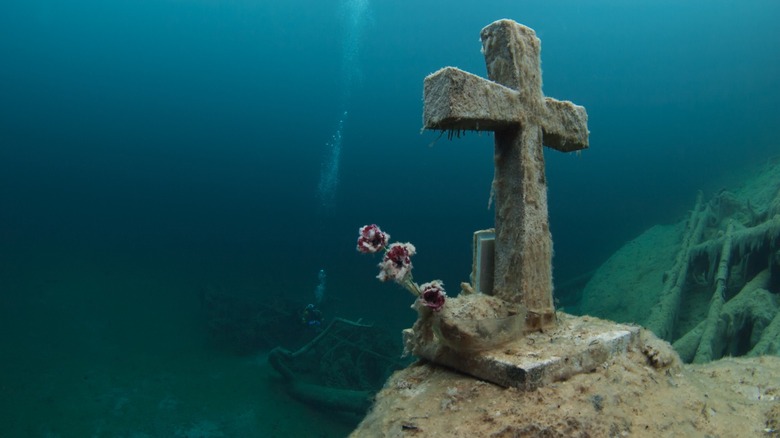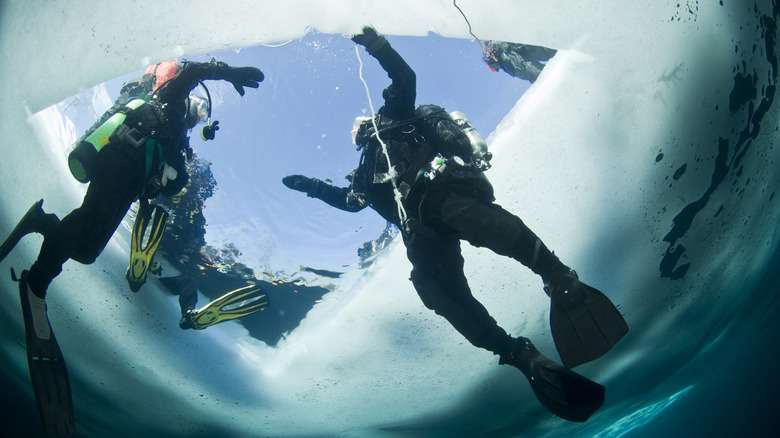The Austrian Alps' Caribbean-Blue Lakes Are A Surreal Diving Mecca With Unique Underwater Landscapes
Crystalline waters that shimmer across an aquamarine spectrum, from emerald to sapphire? High-definition visibility of dazzling marine creatures frolicking among fascinating wrecks? We're not talking about the gorgeous Caribbean Bloody Bay Wall, one of the best dive sites in the world. Look again: Instead of sandy beaches, you're nestled amid the majestic Alps, and it's not palm trees lazily swaying, but regal pine trees. Sometimes there's even snow!
Tucked in the heart of Central Europe, Austria doesn't have a single inch of coastline, yet it offers an unexpectedly surreal diving and snorkeling Mecca all year round. Reminiscent of Disney's "Frozen," Weissensee is a winter diving favorite in Carinthia, with spectacular ice walls soaring 3,050 feet from a pale calcium bed. Or check out Styria's Grüblsee, Europe's highest diving center, at an elevation of 3,800 feet. It's the only Austrian lake where divers can feed fish like trout and sturgeons that grow several feet long while streaming by eclectic curios such as Christmas trees, an armored knight, alien figurines, and Greek statues. These environments are a fun alternative to oceans for exploring underwater landscapes and practicing scuba techniques since fresh water is less buoyant.
Choose your own aquatic adventure, keeping in mind that seasonal conditions dictate what you see and experience – water temperatures evolving from wintry to warm affect clarity, vegetation, and fish movements. The Austrian Dive Card, valid for a year, is necessary for accessing public and private dive sites, but don't worry about packing equipment, as diving centers and clubs rent and sell everything you'll need. Follow comprehensive maps highlighting top attractions posted on site, join a club expedition or guided tour for an insider's immersion, or even learn the sport and get certified if you're a newbie! Snorkeling is welcome at all dive locations.
Dive into the unique underwater landscapes of Austria's alpine lakes
The best part is, you can pair diving and snorkeling in Austria with hiking and snow sports in its famously scenic mountains and still enjoy the cities' world-renowned cultural and culinary treasures. For example, less than two hours' drive from Austria's culinary capital, Graz (with its futuristic art scene), lies Erlaufsee, where trout, grayling, perch, rudd, char, and other resident fish dramatically dart about a nautical forest of half-submerged trees.
The Salzkammergut region is just 30 miles from Salzburg and checks off everything exceptional about Austrian diving, starting at Attersee, the country's largest lake, with a variety of options for beginners, advanced divers, and even kids. An astounding art installation of 111 piles, commemorating all World Heritage Sites, is itself a UNESCO listing. There's also a 50-foot boulder drop for thrill seekers and an ethereal grove of gigantic tree trunks in an underwater forest.
Postcard-worthy Hallstatt is one of Earth's most visited places for its lakeside bliss, but what lies beneath its fjord-like facade is just as breathtaking: Pike, trout, and a plethora of critters dwell among prehistoric trees and a sunken shipwreck, and intrepid romantics can tie the knot at the underwater altar complete with Madonna and child.
To try your flipper at ice diving — an incredibly memorable experience where waters are at their most tranquil and light filtering through solid ice slabs overhead throws playful illuminations underwater — first complete a course at top spots like Weissensee, Attersee, or Hallstatt if you're not accredited. These schools will ensure you're properly geared up for the freezing temperatures. The course plus a weekend expedition costs about $590, or if you're already accredited, a weekend expedition is about $350.

